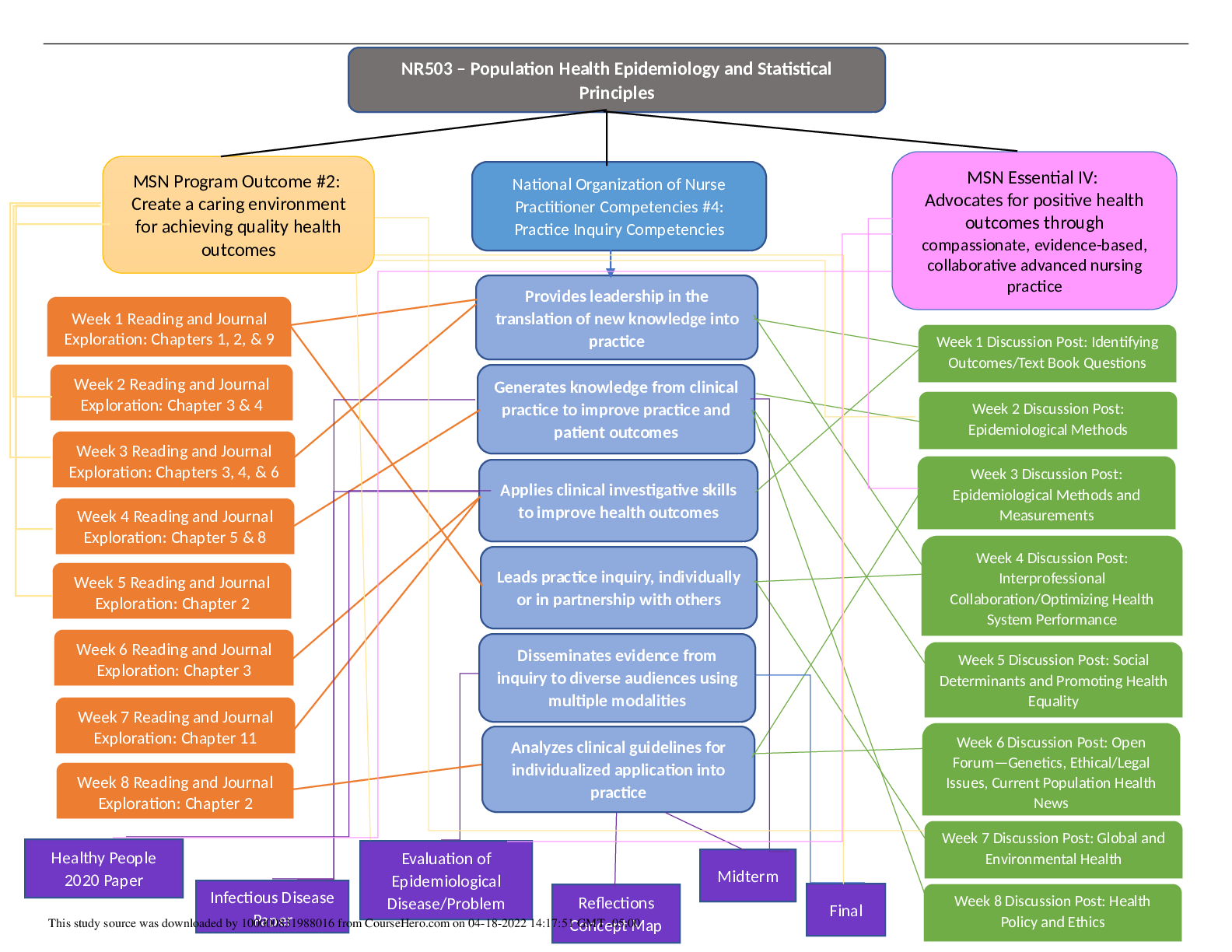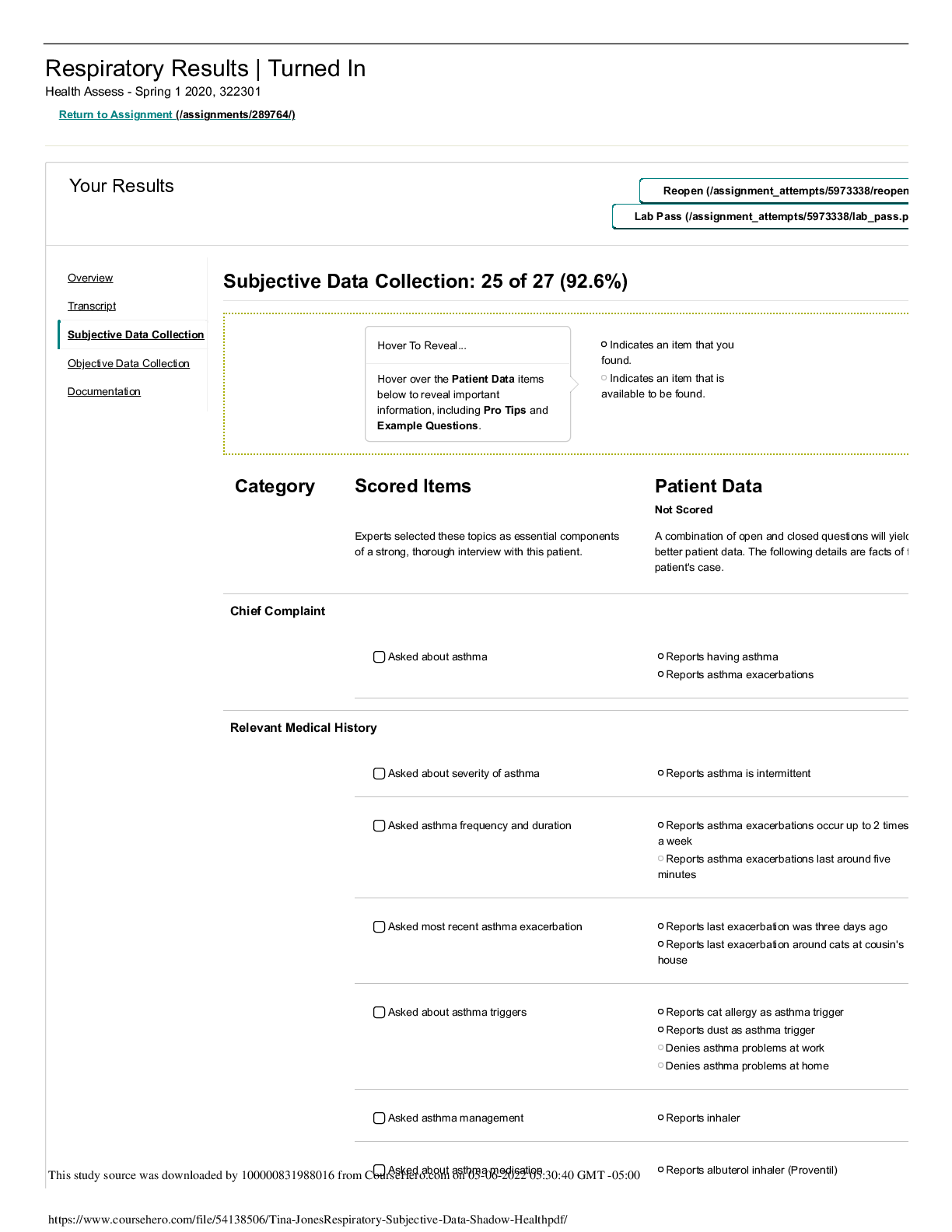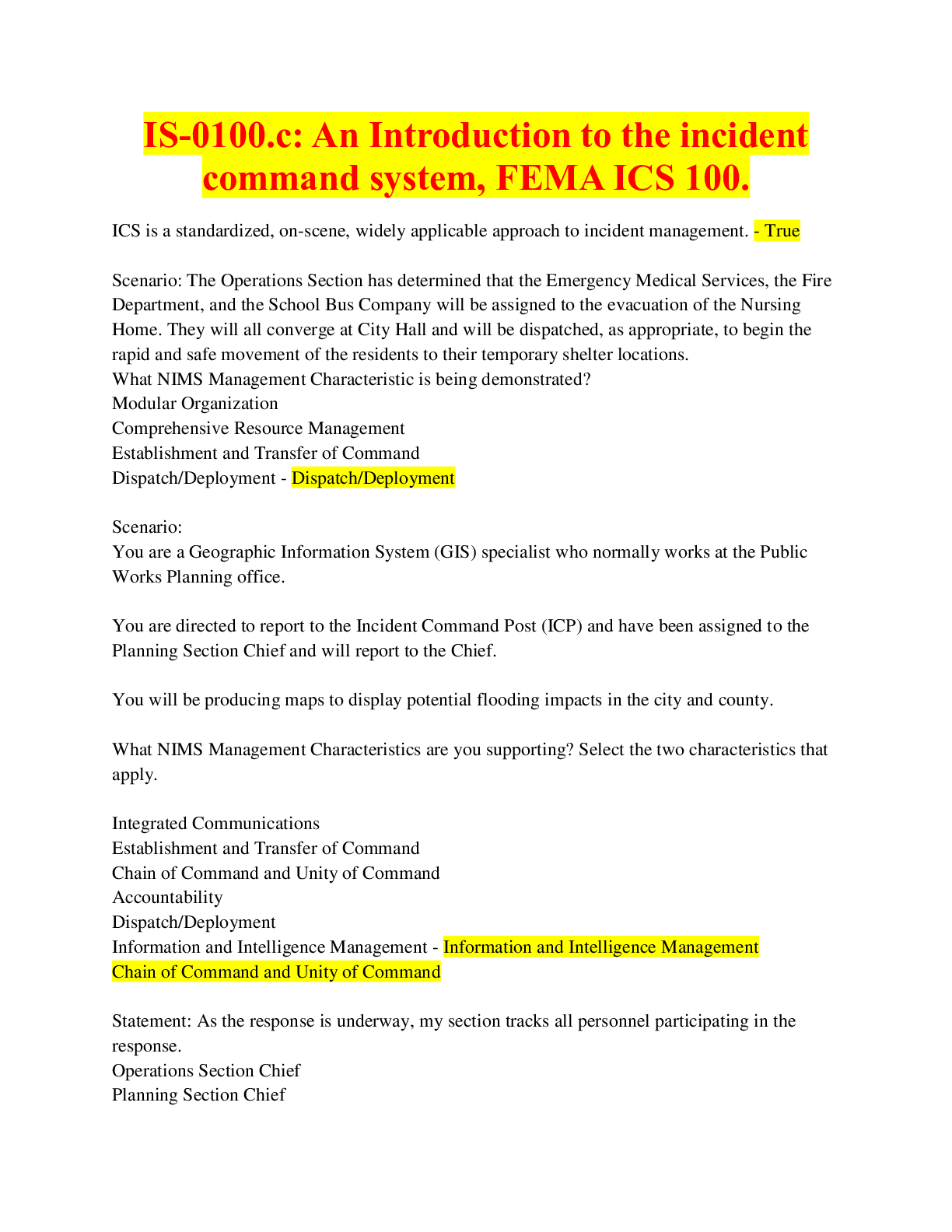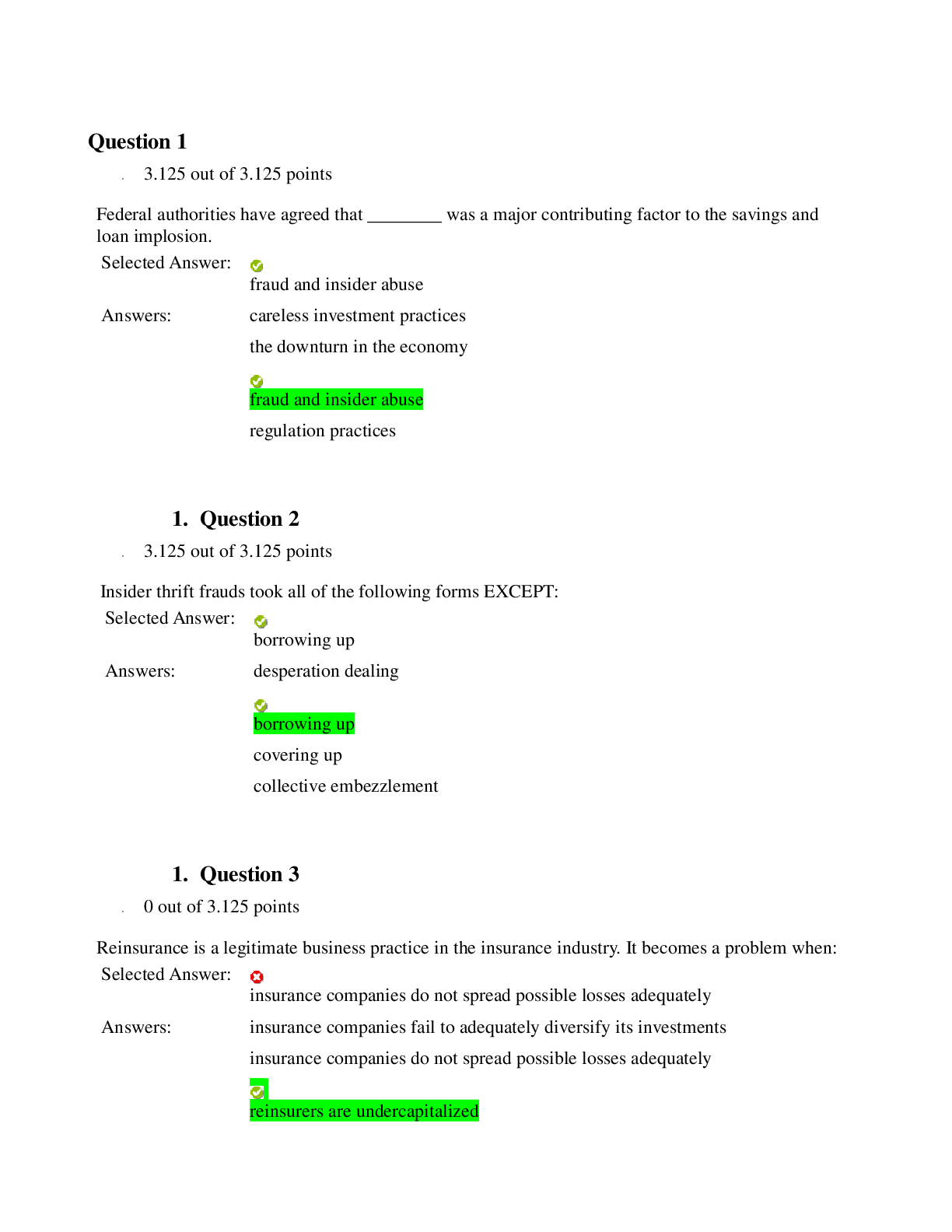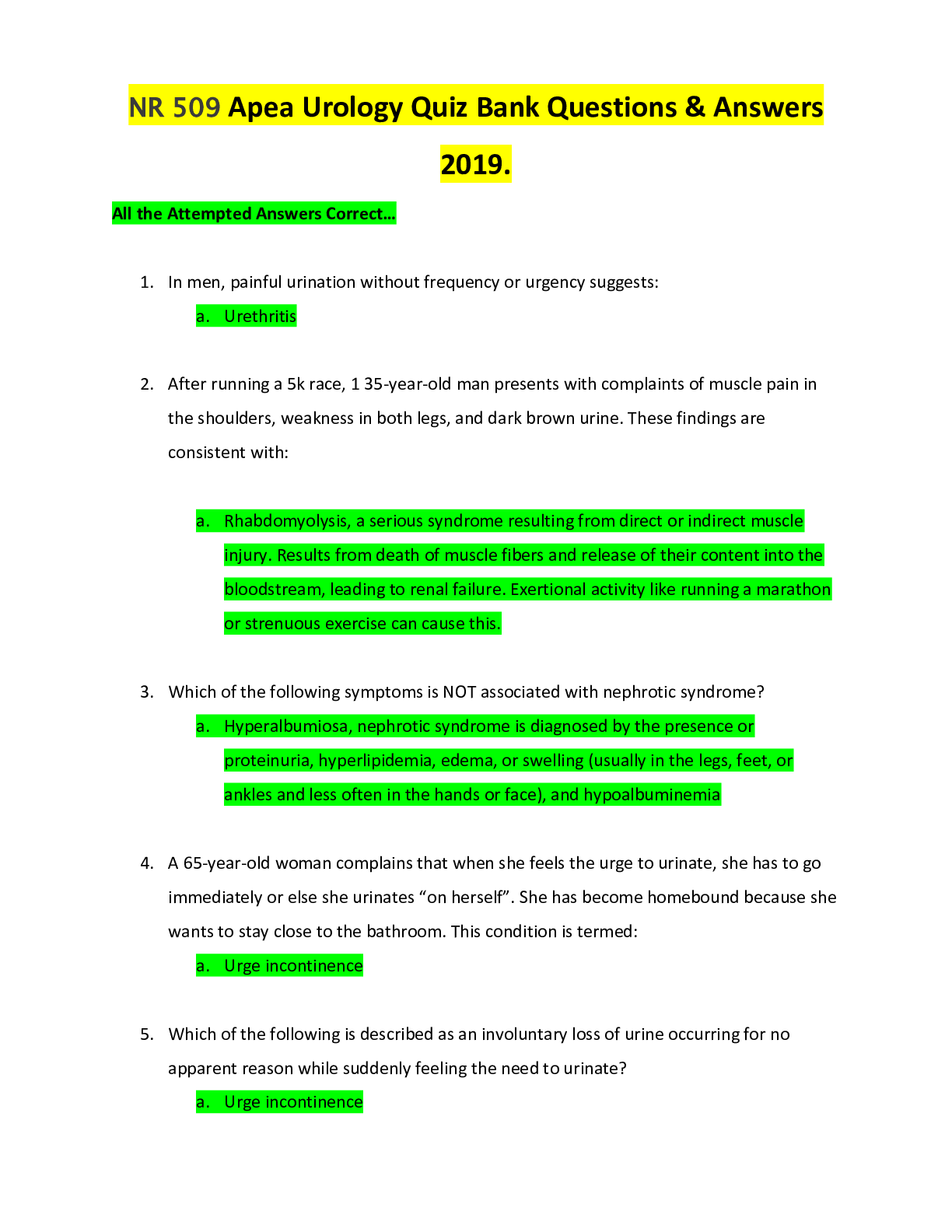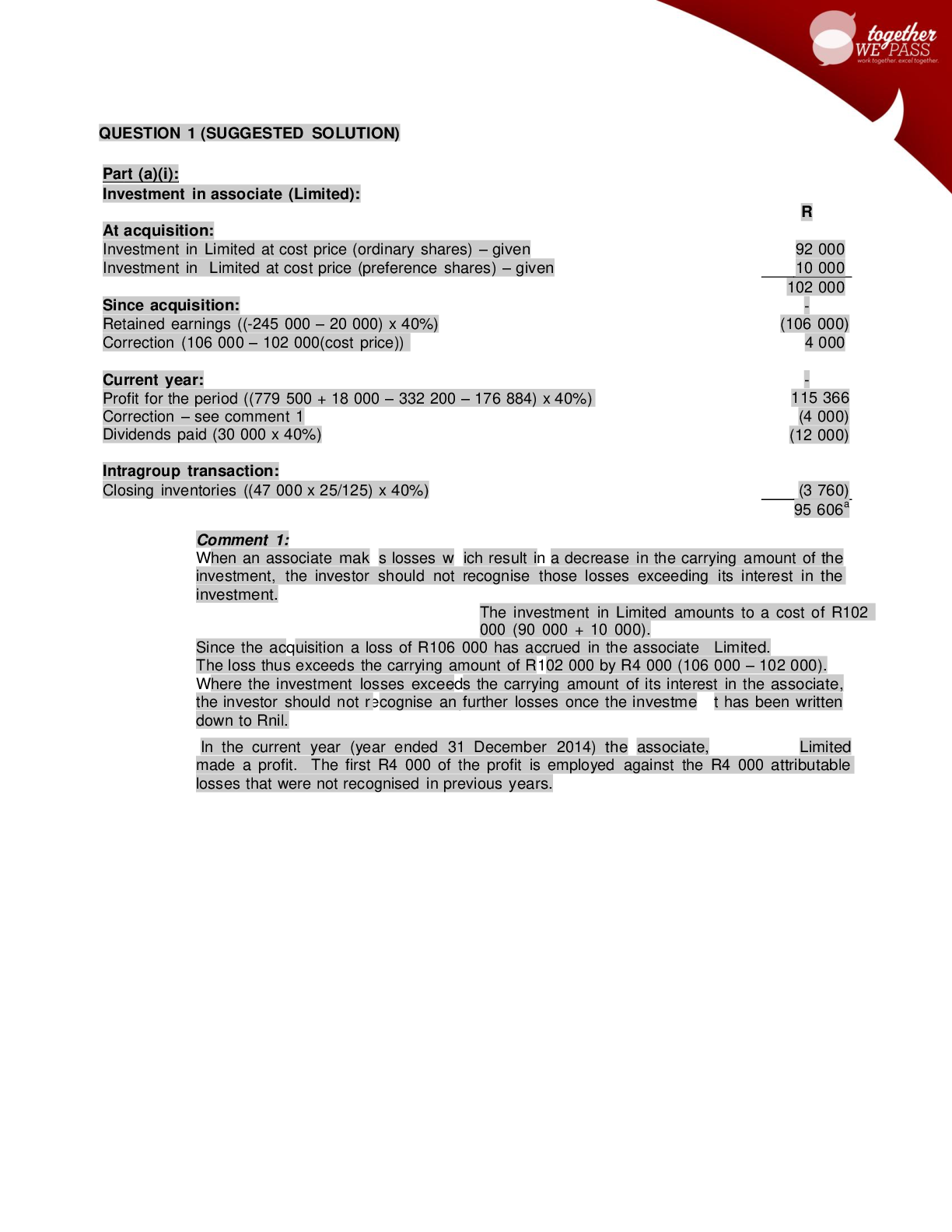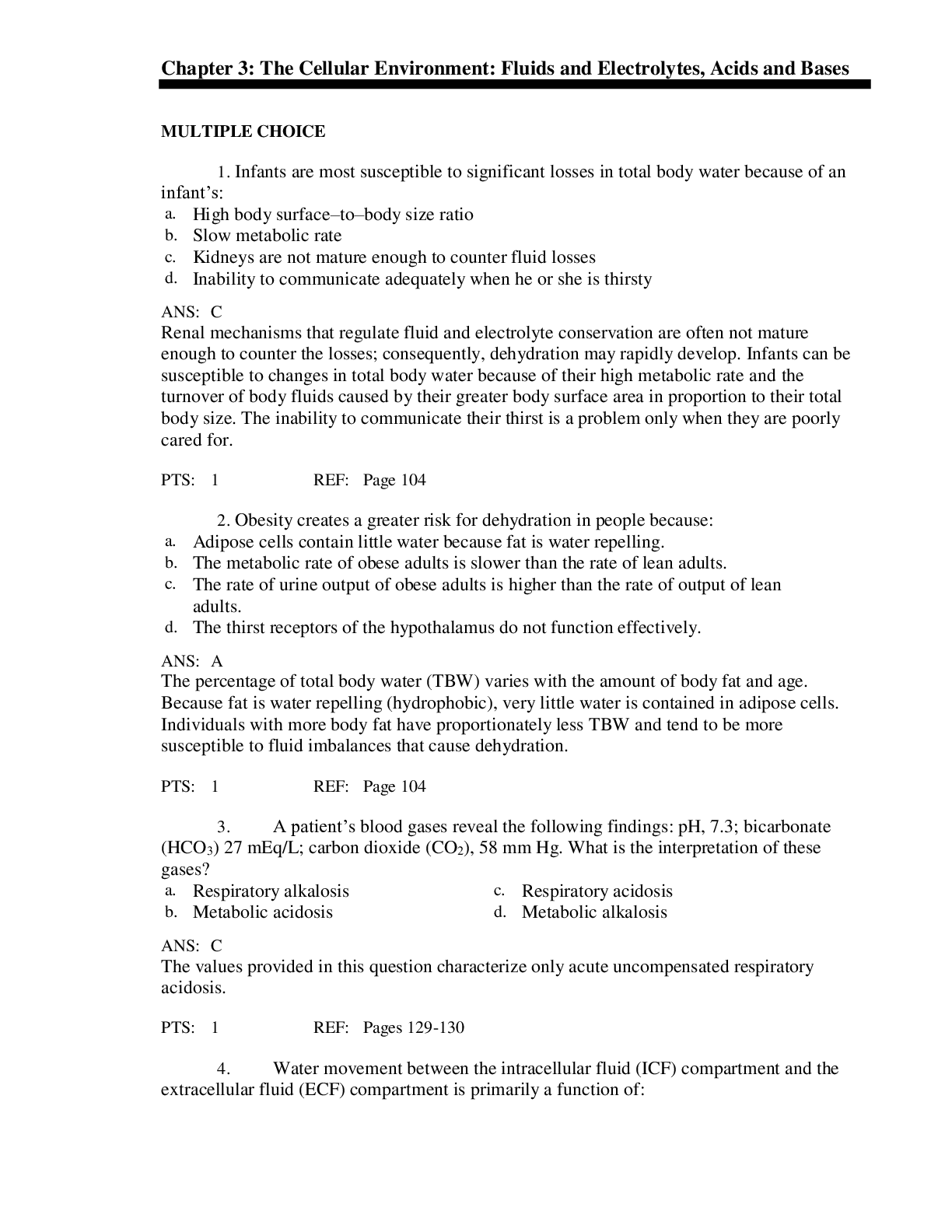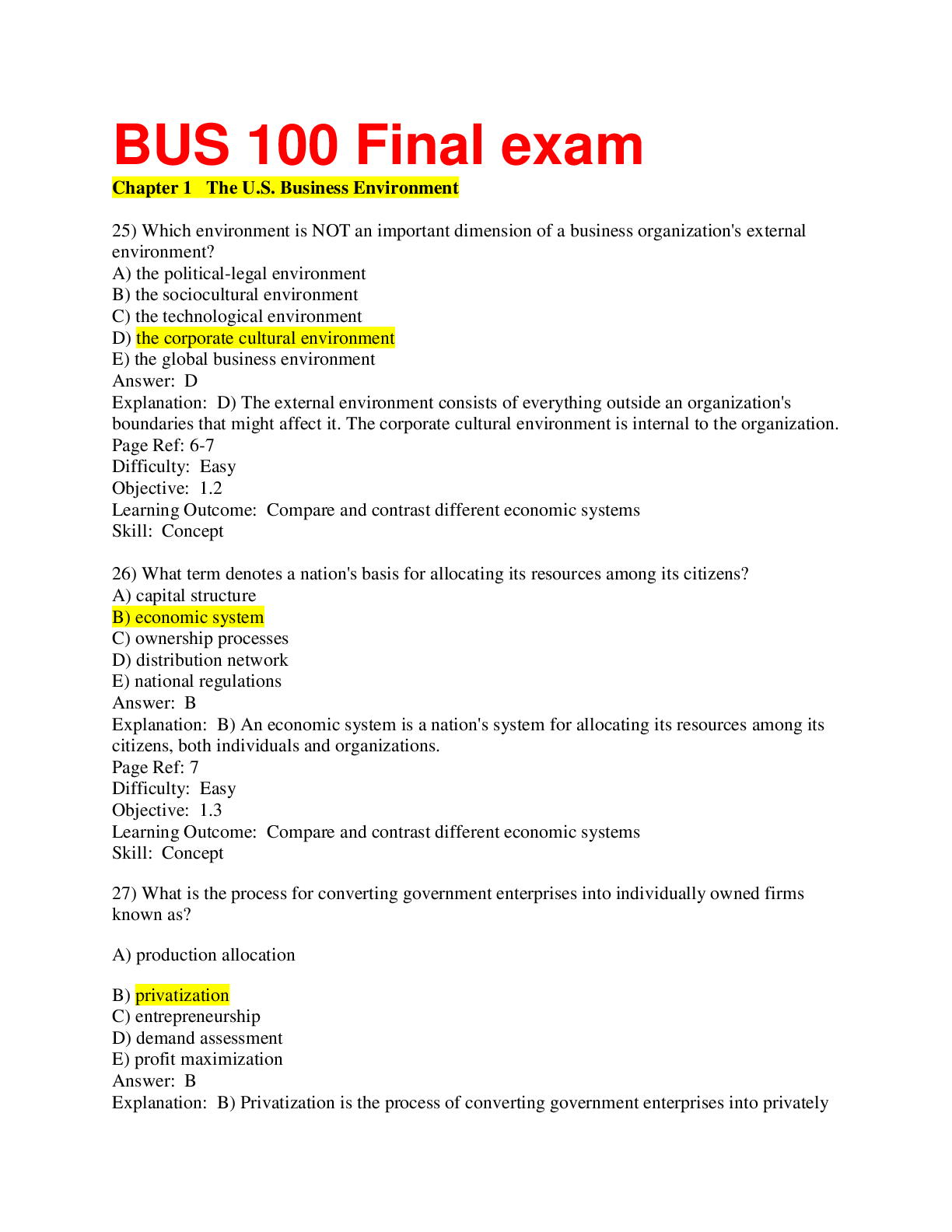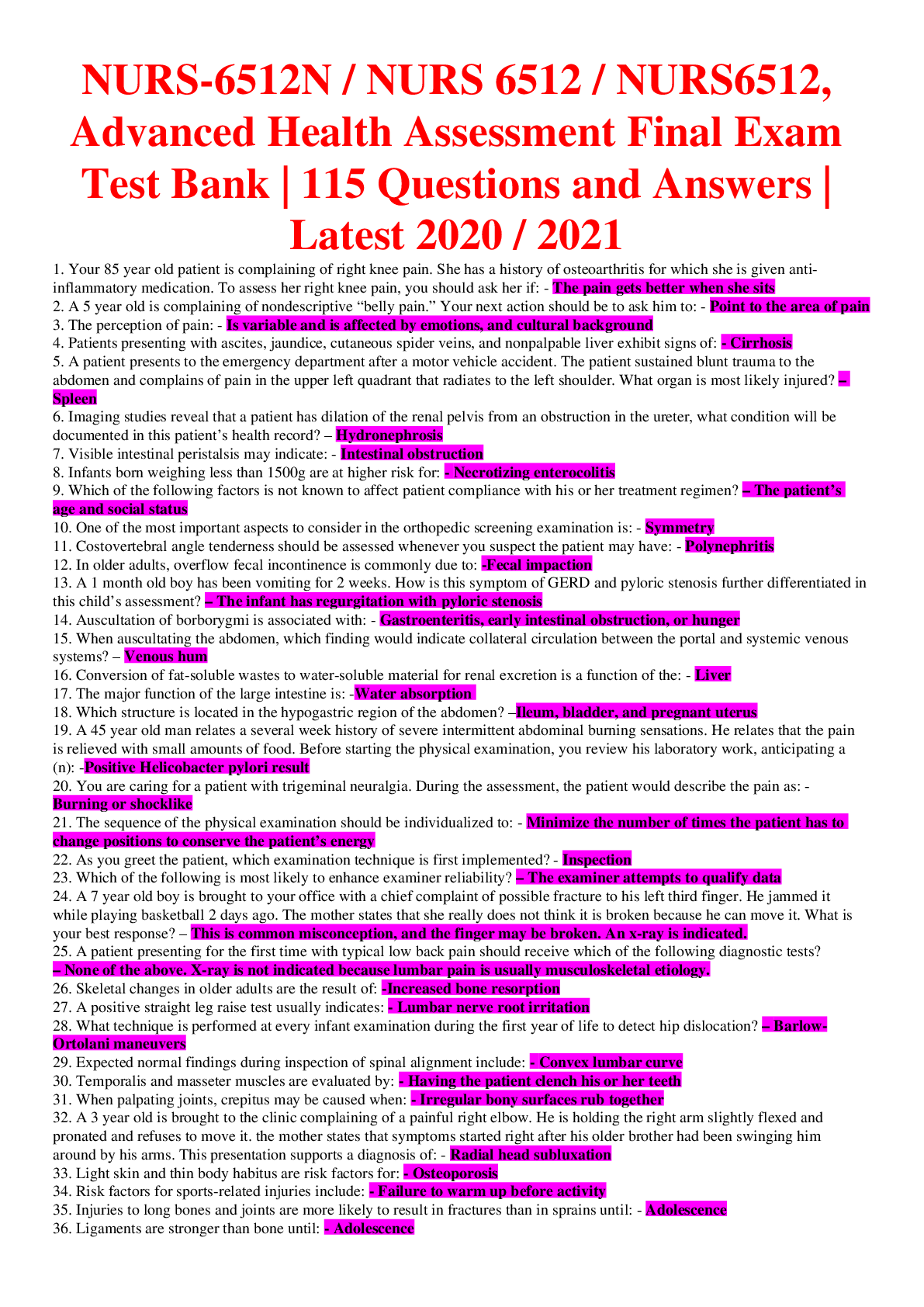Social Sciences > EXAM > LMSW LICENSING EXAM TEST BANK 2022, Answered (All)
LMSW LICENSING EXAM TEST BANK 2022, Answered
Document Content and Description Below
LMSW LICENSING EXAM TEST BANK 2022, Answered -1) A 35-year-old individual has recently experienced the death of a parent and the loss of a job and has increased consumption of alcohol. Which of the fo... llowing areas should be assessed FIRST by the social worker? A. Financial resource availability B. Potential for suicidal behavior C. Need for grief counseling D. Extent of substance abuse - B. Potential for suicidal behavior Rationale: FIRST, the social worker would act to determine the client's safety. The only option that addresses the client's safety is (Key B.) Options a, C, & D may be appropriate later, once the safety of the client has been addressed. 2) The ability to keep personal feelings and needs separate from work relationships BEST represents which social work ethical standard? A. Professional discretion B. Responsibility to the profession C. Professional Boundaries D. Responsibility to colleagues - C. Professional Boundaries Rationale: This requires knowledge of the definition of professional boundaries (key C). Since the question asks for the BEST response, the secondary responsibilities in the other options are not correct. 3. A social worker has been treating a client for two months in an agency setting and is experiencing intense sexual attraction toward the client. The social worker's BEST response is to: A. Consult with an agency supervisor about the case B. Reveal the attraction to the client C. Transfer the client to another agency worker D. Work toward ending the client's services at the agency - A. Consult with an agency supervisor about the case Rationale: Consulting with a supervisor (key A) is the BEST response because it assists in helping to understand and address the situation. Options (B) & (D) are clearly unethical. Transferring the client (C) may be done later, but it is unclear if this action is required at this point and there is not enough information in the stem to conclude this. 4. In a routine review of case records at a mental health center, a social worker supervisor discovers that case managers routinely after all Native American/First Nations clients to either Alcoholics Anonymous or Al-Anon. In discussing this practice with the case managers, the supervisor learns that the referrals are made without obtaining information about the clients' use or abuse of substances. How can the supervisor effectively address the practice? A. Reprimand case managers about providing client services based on stereotyping B. Educate the staff about services provided by Alcoholics Anonymous and Al-Anon C. Provide staff training in culturally competent social work practice. D. Allow no referrals to be made without approval from the supervisor - C. Provide staff training about culturally competent social work practice. 5. At an intake session, a client requests medication for sleep. Since becoming unemployed, the client has used alcohol as a sedative. The client is worried about finances and is afraid of being evicted. The social worker should FIRST: A. Refer the client for evaluation for sleep medication B. Refer the client to public assistance C. Obtain more information about the client's use of alcohol D. Refer the client to the local unemployment office - C. Obtain more information about the client's use of alcohol Rationale: While options A, B & D may all be appropriate actions for the social worker to take, none would be the first. As a part of the assessment process, the social worker needs to FIRST further explore the issue of alcohol use (key C). 6. A client with whom a social worker has worked for several years suddenly dies. The social worker is very distressed by the death. During supervision, the supervisor encourages expressional and ventilation of feelings. The supervisor is providing: A. Education B. Consultation C. Therapy D. Support - D. Support Rationale: The correct answer is (key D) because ventilation is one of the techniques used in providing support. 7. A school-age boy is being beaten almost daily by his father, who has a drug and alcohol problem for which he received no treatment. The boy solves his school conflicts by punching and kicking younger children. The behavior is BEST described as: A. Identification with the abuser B. Hostility toward peers C. Conduct, disorder, childhood onset D. Antisocial personality disorder - A. Identification with the abuser Rationale: This item is a basic recall of cycle of abuse concepts and dynamics. Option (D) is not reasonable given the information in the stem and is not diagnosed until adulthood. He may be hostile toward peers (B), but it is because of his identification with the abuser. Option (C) & (D) are not indicated and do not BEST explain his behavior. (Key A) is the BEST descriptor of what is occurring. 8. Client feedback that indicates a social worker's interpretation is on target is BEST displayed when the client: A. Argues with the social worker B. Changes the subject C. Expresses anger at the social worker D. Discusses related material - D. Discusses related material Rationale: The effectiveness of a response can be accessed through client reaction. Continuing to stay on target in the discussion (Key D) indicates a good progression 9) A social worker administrator is responsible for record keeping at a large agency. Which approach is MOST appropriate for maintaining client records? A. Maintain all records for seven years following termination B. Keep records indefinitely to assure their availability C. Seek permission from clients for destruction of their records D. Store records for the number of years required by law - D. Store records for the number of years required by law Rationale: Social workers are required to follow the laws of the jurisdictions in which they practice. Such statutes vary in their requirements. Hence, the only option that is correct is to maintain files for the length of time required by law (key D). Options A, B & C might not apply in all locations. 10) A school social worker meets with a teenager who is increasingly frustrated and disengaged in school. The student appears to be bright but unmotivated and does not submit completed homework assignments. Meetings with the student have not resulted in changes in the teen's behaviors. What should the social worker do NEXT? A. Consider an alternative educational program for the student B. Arrange for individual tutoring sessions for the teen C. Refer the teen for evaluation by an educational psychologist D. Create a behavioral self-monitoring plan with a student - C. Refer the teen for evaluation by an educational psychologist Rationale: This is an un-scored question. The fact that the student is noted as bright but unmotivated may indicate a learning problem. Of the choices listed, (key C) is the correct answer because the social worker has not been successful in the helping the teen, and the problem may be more than behavioral (D). 11. A doctor notifies a hospital social work that a child with a chronic illness has not kept any appointments in the past year and must be evaluated four times a year. The doctor states that if the child does not come for the appointments, it will be considered medical neglect by the parents. The social worker learns the mother has a physical disability and lives over an hour away from the medical center. The mother asks if the child can be treated at a local medical center instead. What is the MOST appropriate action for the social worker to take? A. Insist that the child go to at least four medical visits per year B. Explore an alternative treatment schedule with the doctor C. Empathize with the mother about limitations of her physical disability D. Determine if the child can receive health care services near the home - D. Determine if the child can receive health care services near the home Rationale: The goal is to find a feasible way for the child to receive medical treatment. Hence, A, B, & C are incorrect because none of them would remove the barriers to the child's medical treatment. Finding health care services near the child's home (key D) could potentially remove one of the perceived barriers. 12. A client is referred to a social worker regarding depression that began eight months earlier. The client reports irritability, sleep problems, and loss of appetite. In exploring the onset of the depression, the social worker learns that the client had an abortion nine months ago. What should the social worker do FIRST? A. Complete a comprehensive eating disorder assessment B. Offer relations strategies to address sleep problems C. Refer the client to a grief and bereavement group D. Ask about the meaning of the abortion to the client - D. Ask about the meaning of the abortion to the client [Show More]
Last updated: 1 year ago
Preview 1 out of 71 pages
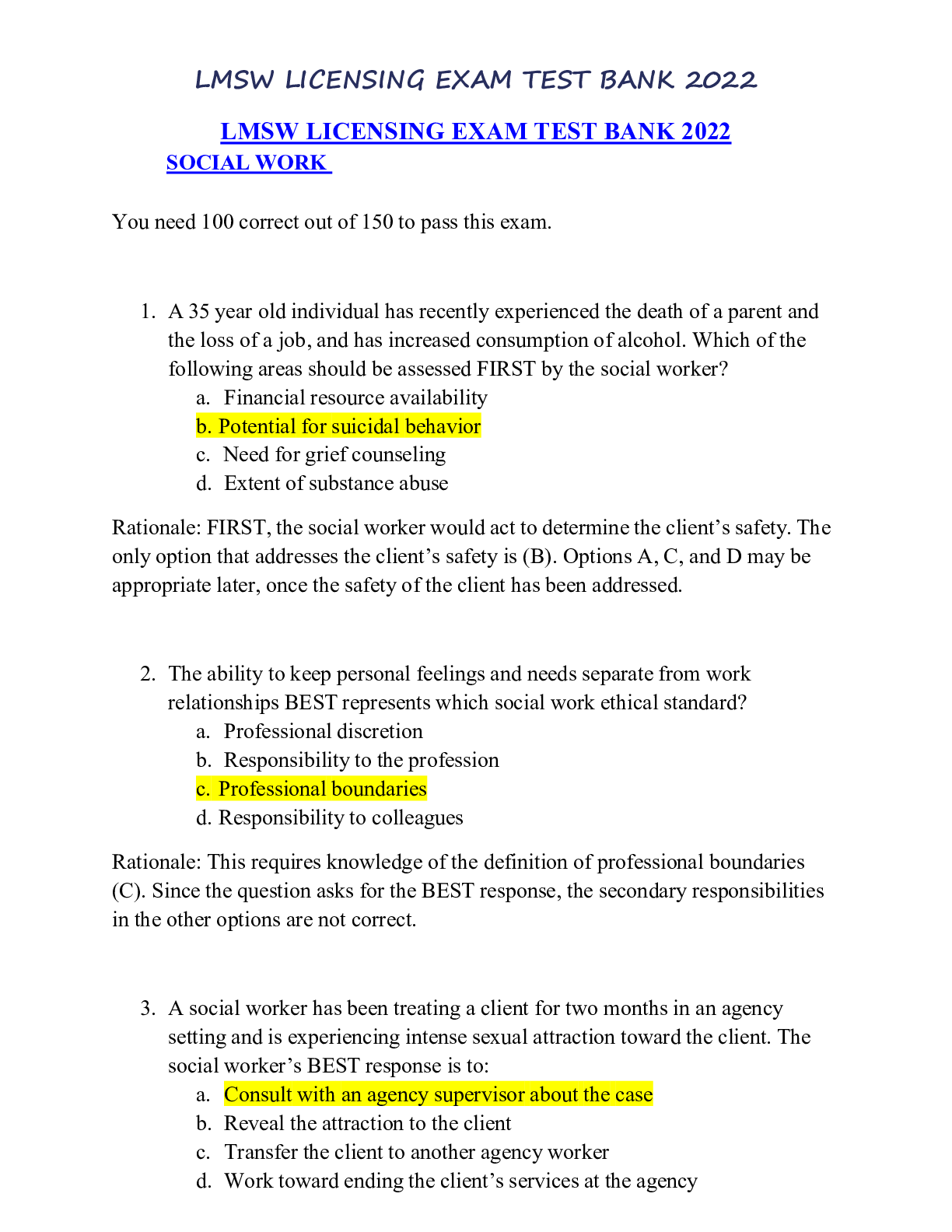
Buy this document to get the full access instantly
Instant Download Access after purchase
Add to cartInstant download
We Accept:

Reviews( 0 )
$13.50
Document information
Connected school, study & course
About the document
Uploaded On
Mar 12, 2022
Number of pages
71
Written in
Additional information
This document has been written for:
Uploaded
Mar 12, 2022
Downloads
0
Views
48






